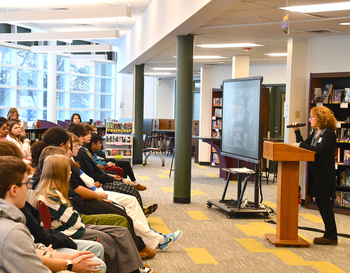Anderson Students Learn Lessons and Hear Personal Stories on Holocaust Remembrance Day

On Monday, January 27, Holocaust Remembrance Day, Anderson Middle School 8th graders heard a presentation from Linda Cohen, an author and daughter of Holocaust survivors.
Ms. Cohen shared her parents, Sarinka and Leon’s, story about how they escaped Yugoslavia and ended up in an internment camp in New York prior to settling in the United States.
Students were captivated by the story, sitting in silence as Linda told the details of her parents’ escape as Jews during World War II, their survival, their loss of family in concentration camps and how they escaped to the United States.
Ms. Cohen wrote a book about their journey to freedom called Sarinka: A Sephardic Holocaust Journey: From Yugoslavia To An Internment Camp in America and she was proud to tell the students her mother had a chance to read the manuscript before she passed away. She told students how she learned her mother’s story when she was a teenager and then continued to learn more as her mother aged.
In closing, Ms. Cohen told the students, “I hope if nothing else, you can walk away knowing what extreme hate can do.”
Here is a brief summary of Sarinka and Leon’s story:
In 1941, the German army invaded Yugoslavia. Sarinka was 23 and Leon was 34 and they were engaged to be married. After a quick wedding and help from neighbors, they went into hiding. Separated from their families, they eventually joined a resistance group called the Partisans, lived in the forest for months and ran and hid for three years, eventually finding shelter in southern Italy.
In 1944, President Roosevelt announced a program to take up to 1,000 refugees of war into the US with the mandate that they return to their country after the war was over. Her parents were lucky to get on the list and were transported to northern New York and lived in an internment camp in the town of Oswego. From 1944 to 1946, Fort Ontario Emergency Refugee Shelter served as the only shelter in the United States for Jewish refugees fleeing the Holocaust.
At the Emergency Refugee shelter, residents did not have free will in the US, but their quality of life did improve. Sarinka and Leon learned English and kindness, and had food and shelter. Linda’s mother met a local resident who brought her food and showed her kindness. “She saved her life in a different way,” Ms. Cohen shared.
In 1945, President Truman allowed the refugees to become immigrants. In 1946 they were allowed to leave the camp and they left for Baltimore to establish a new life with friends from the camp, who became their only family.
After the war, her parents learned that their families in Yugoslavia were murdered in the concentration camps and they had no one left. They shared their story of survival and of their loved ones' peril with their children and grandchildren so it would not be forgotten.
While the 8th graders were learning from Ms. Cohen, 6th and 7th graders learned more about the Holocaust in their homeroom class.
6th graders began by learning the definition of the Holocaust. They also learned about the timeline of the Holocaust and watched videos about Kristallnacht, the ghettos and stories from liberators and survivors. During these lessons students shared what they already knew about the Holocaust, what they wondered about, and at the end of the lesson each student wrote on a paper flame what they learned and why we should never forget the Holocaust.
7th graders learned the history of antisemitism and how propaganda was used to spread fear and prevent resistors during the Holocaust. Students participated in a gallery walk that focused on several groups/individuals whose efforts helped to save Jews in Europe during the war.





